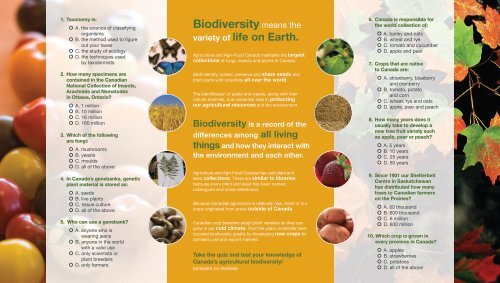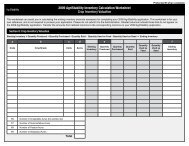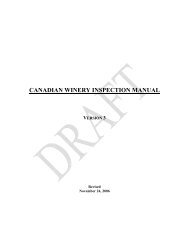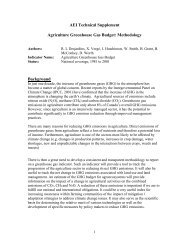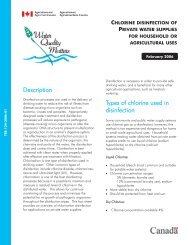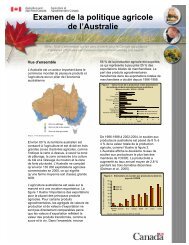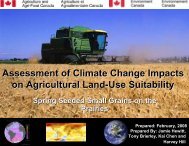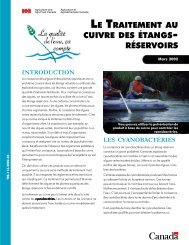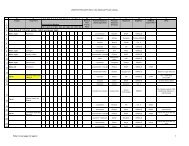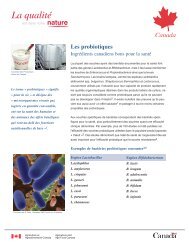Biodiversity means the
Biodiversity means the
Biodiversity means the
- No tags were found...
Create successful ePaper yourself
Turn your PDF publications into a flip-book with our unique Google optimized e-Paper software.
1. Taxonomy is:A. <strong>the</strong> science of classifyingorganismsB. <strong>the</strong> method used to figureout your taxesC. <strong>the</strong> study of ecologyD. <strong>the</strong> techniques usedby taxidermists2. How many specimens arecontained in <strong>the</strong> CanadianNational Collection of Insects,Arachnids and Nematodesin Ottawa, Ontario?A. 1 millionB. 10 millionC. 16 millionD. 160 million3. Which of <strong>the</strong> followingare fungi:A. mushroomsB. yeastsC. mouldsD. all of <strong>the</strong> above4. In Canada’s genebanks, geneticplant material is stored as:A. seedsB. live plantsC. tissue cultureD. all of <strong>the</strong> above5. Who can use a genebank?A. anyone who iswearing jeansB. anyone in <strong>the</strong> worldwith a valid useC. only scientists orplant breedersD. only farmers<strong>Biodiversity</strong> <strong>means</strong> <strong>the</strong>variety of life on Earth.Agriculture and Agri-Food Canada maintains <strong>the</strong> largestcollections of fungi, insects and plants in Canada.Staff identify, collect, preserve and share seeds andplant parts with scientists all over <strong>the</strong> world.The identification of pests and weeds, along with <strong>the</strong>irnatural enemies, is an essential step in protectingour agricultural resources and <strong>the</strong> environment.<strong>Biodiversity</strong> is a record of <strong>the</strong>differences among all livingthings and how <strong>the</strong>y interact with<strong>the</strong> environment and each o<strong>the</strong>r.Agriculture and Agri-Food Canada has vast plant andseed collections. These are similar to librariesbecause every plant and seed has been named,catalogued and cross-referenced.Because Canadian agriculture is relatively new, most of ourcrops originated from areas outside of Canada.Canadian crop breeders adapt plant varieties so <strong>the</strong>y cangrow in our cold climate. Over <strong>the</strong> years, scientists haveboosted biodiversity greatly by developing new crops fordomestic use and export markets.Take <strong>the</strong> quiz and test your knowledge ofCanada’s agricultural biodiversity!(answers on reverse)6. Canada is responsible for<strong>the</strong> world collection of:A. barley and oatsB. wheat and ryeC. tomato and cucumberD. apple and pear7. Crops that are nativeto Canada are:A. strawberry, blueberryand cranberryB. tomato, potatoand cornC. wheat, rye and oatsD. apple, pear and peach8. How many years does itusually take to develop anew tree fruit variety suchas apple, pear or peach?A. 5 yearsB. 10 yearsC. 25 yearsD. 50 years9. Since 1901 our ShelterbeltCentre in Saskatchewanhas distributed how manytrees to Canadian farmerson <strong>the</strong> Prairies?A. 60 thousandB. 600 thousandC. 6 millionD. 600 million10. Which crop is grown inevery province in Canada?A. applesB. strawberriesC. potatoesD. all of <strong>the</strong> above
What’s Your<strong>Biodiversity</strong> IQ?Give yourself one point for every correct answer andsee how you measure up.10<strong>Biodiversity</strong> genius. Way to go!7 to 9Bio-brainiac. You have a great understanding of<strong>the</strong> variety of life on earth, and Canada’s role inpreserving it.4 to 6Bio-aware. You have some idea of <strong>the</strong> scope ofCanada’s biodiversity. On your next visit to <strong>the</strong>grocery store or park, stay alert: <strong>the</strong>re’s a LOTto discover!0 to 3Bio-hazard! You may want to spend more timedigging around in your backyard…where you willdiscover hundreds of examples of biodiversityat work!Quiz Answers:1. Taxonomy is…A. The science of classifying organisms.Agriculture and Agri-Food Canada scientistsare world-class experts on indentifyingplants, insects, mites, nematodes, fungi,bacteria and plant viruses.2. How many specimens arecontained in <strong>the</strong> Canadian NationalCollection of Insects, Arachnidsand Nematodes in Ottawa, Ontario?C. 16 million. Although <strong>the</strong>re are largerinsect collections, ours is considered oneof <strong>the</strong> best collections in <strong>the</strong> world in termsof size, different species and expertise of ourstaff. Our entomologists share informationwith scientists around <strong>the</strong> world.3. Which of <strong>the</strong> following are fungi:D. All of <strong>the</strong> above….and much more,including mildew, puffballs, morels andtruffles. The grocery store offers a variety ofedible mushrooms to eat. Yeast is neededto make bread, wine and beer. Good mouldsare used to make delicious blue cheeses.4. In Canada’s genebanks, geneticplant material is stored as:D. All of <strong>the</strong> above. Tissue culture <strong>means</strong>we can grow a whole plant from a smallpiece of plant material. This is done in a labin a controlled, disease-free environment.5. Who can use a genebank?B. Anyone in <strong>the</strong> world with a valid use.Scientists from all over <strong>the</strong> world ask toborrow and trade packets of seeds andplants. The biggest users are plant breedersand researchers, but medical researchersand educators are also welcome.6. Canada is responsible for <strong>the</strong>world collection of:A. Barley and oats. Barley and oats areextremely valuable crops both in Canadaand around <strong>the</strong> world. Consumers around<strong>the</strong> world make oats into nutritious granolabars and use barley to make tasty beer.7. Crops that are native toCanada are:A. Strawberry, blueberry and cranberry.Our Aboriginal Peoples found <strong>the</strong>se sweettreats and <strong>the</strong>y are still popular today as ahealthy food source.8. How many years does it usuallytake to develop a new tree fruit varietysuch as apple, pear or peach?C. 25 years. New orchards are developed so<strong>the</strong>y can resist pests, diseases and environmentalstresses such as drought. Many treesare bred to be short so that fruit pickers don’thurt <strong>the</strong>mselves climbing on high ladders.9. Since 1901 our ShelterbeltCentre in Saskatchewan hasdistributed how many trees toCanadian farmers on <strong>the</strong> Prairies?D. 600 million trees. Trees are an excellentresource for farmers. Shelterbelts protect<strong>the</strong> land from wind and soil erosion. Treesalso provide shade for livestock in <strong>the</strong>summer as well as create a habitat forbirds and smaller critters.10. Which crop is grown in everyprovince in Canada?D. All of <strong>the</strong> above. The Government ofCanada has invested in crop researchfor farmers over <strong>the</strong> last 125 years. Ourscientists need to develop crops thatsprout, grow, mature and produce abountiful crop in about 100 days.What Is Agricultural <strong>Biodiversity</strong>?Test Your Knowledge! Take The Quiz!Want to learn MORE aboutagriculture and biodiversity?Check out www.agr.gc.ca/biodiversityfor more resources and to discover how Canadianscientists and <strong>the</strong> Government of Canada areworking to preserve and promote our biodiversity.For additional copies of this publicationor to request an alternate format,please contact:Publications SectionAgriculture and Agri-Food CanadaPhone: (613) 773-1444Fax: (613) 773-1498Email: publications@agr.gc.caElectronic version available at:www.agr.gc.ca/students© Her Majesty <strong>the</strong> Queen in Rightof Canada, 2010Catalogue No. A22-517/2010EISBN 978-1-100-16384-0AAFC No. 11246EAussi offert en français sous le titre :Jeu-questionnaire papier sur la biodiversité50% post-consumer content


